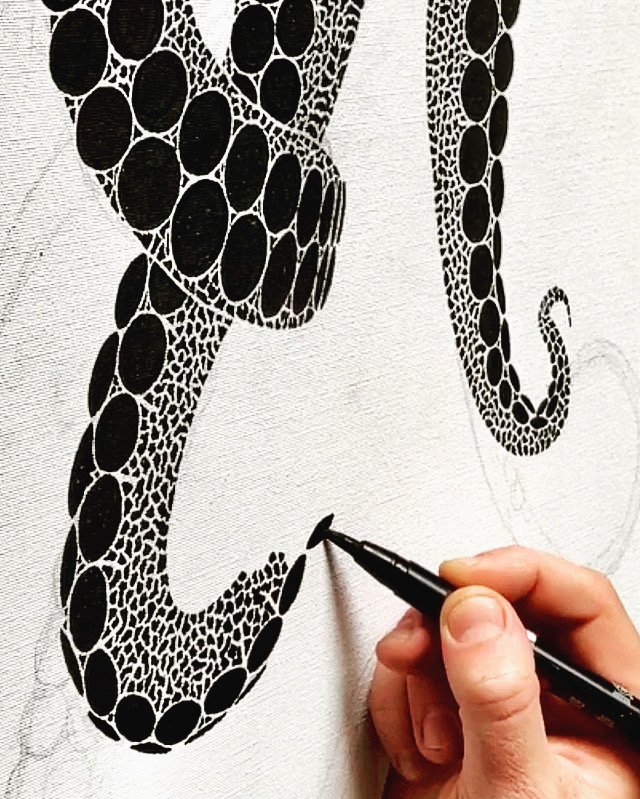Kraken
The creation of Kraken was a personal voyage into the depths of both the ocean’s mysteries and artistic exploration. Named for the legendary sea creature of Greek lore, I sought through this painting to offer an intimate glimpse into the natural world by bringing to life the tangible yet equally impressive and enigmatic Giant Pacific Octopus - the largest of all octopus species. Yet, beyond its size and mythic allure, it was the octopus’s inherent complexity and alienness that compelled me to break free of the constraints I had long worked within to brave a new medium.
Kraken marked a notable shift in my art practice, from smaller paper works requiring 15-25 hours of work, to a far more expansive size of 100 x 70 cm that ended taking more than 130 hours to complete. After a lifetime of drawing, the decision to paint my first large-scale artwork was propelled by the sense that it was time to move beyond the limits of format that had defined my art for years. The Giant Pacific Octopus, with its fluid grace and intricate anatomy, emerged as a subject befitting the challenge of this larger scale, offering a canvas as impressive and seemingly unknowable as the creature’s own natural habitat.
The preparation for Kraken felt as much like an academic endeavor as an artistic one, involving many hours of anatomical study across the myriad species of octopuses and wider cephalopods, trying to absorb as much detail as possible of their form, movement, and behavior. This deep dive eventually led to me choosing a specific pose that captured the striking essence of the Giant Pacific Octopus, inspired by a captivating photograph of one such specimen unfurled as it descends upon its prey.
Kraken is an exploration of form and detail through simplicity. The whole is an amalgam of thousands of meticulously placed particulates, painted with painstaking precision to show the patterns of the octopus’s chameleonic skin, and to give it perspective by mimicking the folds and movements of its head, arms, and suction cups. These particulates emulate the creature’s chromatophores, reflecting the octopus's ability to change color and texture, to create something existing in a realm between the imagined and the real. The use of negative space and a monochromatic palette places every element on a single plane, mirroring a shattered pane of glass through which the creature is at once breaking out and caving in. All these stylistic choices invite the viewer to engage with the piece from many angles, visually and emotionally.
Reflecting on the creation of Kraken, I recognize that the piece was initially a personal challenge, a test of my aptitude for painting, and a deliberate step beyond my own artistic boundaries. But along the way it evolved into something far more profound, becoming a personal meditation on the variety and complexity of life, the necessity of adaptability, and the capacity for empathy across the vast divides of nature. In a way, this octopus, one of the most alien things on this planet that I can think of, became a way for me to explore these themes, a bridge between the known and the unknown, the self and the other.
However, the journey did not end with the final brushstroke. As I spent months of introspection after its completion reconciling all the learnings from my experience making this behemoth, I found new ways to “evolve” Kraken by using other creative platforms to express different aspects of the piece and to make it interactive. I created two augmented reality animation overlays - the first frame by frame, the second using generative visuals software set to a music track of my own drumming and composition - alongside colorized print designs to experience them. With these prints and animations, I wanted not only to showcase the octopus’s chromatic superpowers, but also to share a view into the silent, frenetic energy that fueled the creation of the painting.
These iterations allowed me to expand the narrative of the piece, by adding new dimensions and giving viewers a chance to engage with the artwork in dynamic and immersive ways. Having spent so much time dedicated to creating the painting, the animations also helped me reach a certain sense of closure, with the artwork now feeling like a total, complete expression of my original vision. Thinking back on the sense of cerebral “loss” that I felt in the aftermath of the painting, this process underscored the realization that the creative process never truly has to be finished; it is a living dialogue between the artist, the creation, and the audience.
In painting Kraken, I embarked on a journey that challenged not only my skills as an artist but my perceptions of what art could be. It was a venture that brought me face to face with the frustrations and limitations of my craft, pushing me to explore new methodologies and mediums. The lessons learned from Kraken have profoundly shaped my approach to art, instilling in me a deeper appreciation for the process and pains of creation, and the possibilities it holds even after it is done.



